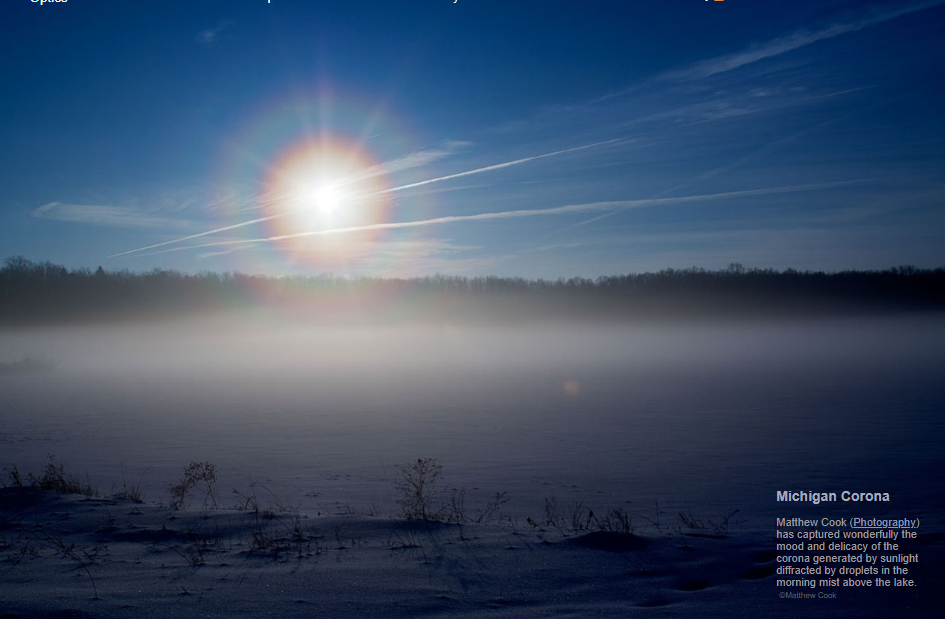OPOD - Michigan Corona
OPOD - Michigan Corona: A Captivating Display of Atmospheric Optics
When it comes to atmospheric optics, there are few phenomena as mesmerizing as a corona. The delicate interplay of sunlight and water droplets creates a captivating spectacle that can be truly awe-inspiring. One such example is the Michigan Corona, beautifully captured by Matthew Cook in his stunning photograph. Let's delve into the details of this remarkable display and explore the science behind it.
The image, taken by Matthew Cook at Mill Lake in the Waterloo State Recreation Area near Waterloo, Michigan, showcases the corona in all its glory. The photograph was captured shortly after sunrise, when the temperature hovered around 10 Fahrenheit. Over the lake, a thin layer of fog was dissipating rapidly as the wind speed increased. It was during this transient moment that Cook seized the opportunity to immortalize the ethereal beauty of the corona.
To achieve the desired effect, Cook employed a technique known as exposure bracketing. By taking several shots at different exposure settings, he ensured that no detail was lost in the process. These images were then combined using layers of varying opacity, allowing him to create a final composite that faithfully represented the scene's dynamic range. The result is a visually striking photograph that captures the essence of the Michigan Corona.
Now, let's delve deeper into the science behind this atmospheric phenomenon. A corona is formed when sunlight interacts with tiny water droplets or ice crystals suspended in the air. As light passes through these particles, it undergoes diffraction, causing it to spread out and form a circular pattern around the source of illumination. This creates a halo-like effect that can be observed around the sun or moon.
The size and color of a corona depend on several factors, including the size and shape of the water droplets or ice crystals, as well as the angle at which sunlight strikes them. In the case of the Michigan Corona, the droplets in the morning mist above the lake played a crucial role in creating the breathtaking display. The diffraction of sunlight by these droplets resulted in a corona with a delicate, ethereal appearance.
It's worth noting that coronas are not limited to Michigan or any specific location. They can occur in various atmospheric conditions, provided there are sufficient water droplets or ice crystals present. In fact, coronas are often observed in association with clouds, fog, or mist. These atmospheric conditions create the perfect environment for the formation of these captivating optical phenomena.
To fully appreciate the beauty of a corona, it's essential to observe it from the right vantage point. Viewing a corona requires positioning oneself so that the light source, such as the sun or moon, is partially obscured. This can be achieved by using natural obstructions like trees or buildings as a frame of reference. By blocking out the direct light, one can focus on the intricate patterns and colors that make up the corona.
In conclusion, the Michigan Corona captured by Matthew Cook is a testament to the captivating beauty of atmospheric optics. Through his skillful photography, Cook has immortalized a fleeting moment of natural splendor. The interplay of sunlight and water droplets in the morning mist above the lake created a corona that is both delicate and enchanting. It serves as a reminder of the wonders that can be found in the ever-changing tapestry of our atmosphere.

Michigan Corona
Matthew Cook (Photography) has captured wonderfully the mood and delicacy of the corona generated by sunlight diffracted by droplets in the morning mist above the lake. ©Matthew Cook
"The image was taken not too long after sunrise at Mill Lake in the Waterloo State Recreation Area near Waterloo, Michigan. The temperature was around 10 Fahrenheit - what appeared to be fog over the lake was dissipating quickly and the wind speed was picking up. I set up the camera and took several shots bracket two stops apart - I then combined them in layers of varying opacity 100%, 50%, 33% etc. - a technique I often use for dealing with scenes with too much dynamic range. I'm usually not a fan of HDR looking images."
Note: this article has been automatically converted from the old site and may not appear as intended. You can find the original article here.
Reference Atmospheric Optics
If you use any of the definitions, information, or data presented on Atmospheric Optics, please copy the link or reference below to properly credit us as the reference source. Thank you!
-
<a href="https://atoptics.co.uk/blog/opod-michigan-corona/">OPOD - Michigan Corona</a>
-
"OPOD - Michigan Corona". Atmospheric Optics. Accessed on November 26, 2024. https://atoptics.co.uk/blog/opod-michigan-corona/.
-
"OPOD - Michigan Corona". Atmospheric Optics, https://atoptics.co.uk/blog/opod-michigan-corona/. Accessed 26 November, 2024
-
OPOD - Michigan Corona. Atmospheric Optics. Retrieved from https://atoptics.co.uk/blog/opod-michigan-corona/.